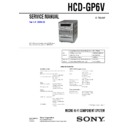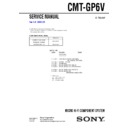Read Sony CMT-GP6V / HCD-GP6V Service Manual online
SERVICE MANUAL
Sony Corporation
Home Audio Division
Published by Sony Techno Create Corporation
Published by Sony Techno Create Corporation
E Model
MICRO HI-FI COMPONENT SYSTEM
9-877-654-04
2006B16-1
© 2006.02
© 2006.02
Ver 1.3 2006.02
SPECIFICATIONS
HCD-GP6V
Model Name Using Similar Mechanism
CX-LFAV500
CD
CD Mechanism Type
CDM55A-30BD61S
Section
Base Unit Name
BU-30BD61S
Optical Pick-up Name
A-MAX.3
Tape deck
Model Name Using Similar Mechanism
HCD-GP5
Section
Tape Transport Mechanism Type
CMAL1Z240A
HCD-GP6V is the Amplifier, Video CD/CD player,
Tape Deck and Tuner section in CMT-GP6V.
Tape Deck and Tuner section in CMT-GP6V.
— Continued on next page —
Amplifier section
The following measured at AC 240 V or AC 120 V, 50/
60 Hz
DIN power output (rated): 20 + 20 W
60 Hz
DIN power output (rated): 20 + 20 W
(6 ohms at 1 kHz, DIN)
Continuous RMS power output (reference):
30 + 30 W
(6 ohms at 1 kHz, 10%
THD)
(6 ohms at 1 kHz, 10%
THD)
Inputs
MD IN (phono jacks):
MD IN (phono jacks):
Sensitivity 500 mV,
impedance 47 kilohms
impedance 47 kilohms
MIC (phone jack):
Sensitivity 1 mV,
impedance 10 kilohms
impedance 10 kilohms
Outputs
PHONES (stereo minijack):
PHONES (stereo minijack):
Accepts headphones with
an impedance of 8 ohms or
more
an impedance of 8 ohms or
more
VIDEO OUT (phono jack):
Max. output level 1Vp-p,
unbalanced, Sync
negative, load impedance
75 ohms
unbalanced, Sync
negative, load impedance
75 ohms
SPEAKERS:
Accepts impedance of 6 to
16 ohms.
16 ohms.
VIDEO CD/CD player section
System
Compact disc and digital
audio system
audio system
Laser
Semiconductor laser
(
(
λ=780 nm)
Emission duration:
continuous
continuous
Frequency response
2 Hz – 20 kHz (
±0.5 dB)
Wavelength
780 – 790 nm
Signal-to-noise ratio
More than 90 dB
Dynamic range
More than 90 dB
Video color system format
NTSC, PAL
Tape deck section
Recording system
4-track 2-channel stereo
Frequency response
50 – 13,000 Hz (
±3 dB),
using Sony TYPE I
cassettes
cassettes
2
HCD-GP6V
Tuner section
FM stereo, FM/AM superheterodyne tuner
FM tuner section
Tuning range
87.5 – 108.0 MHz
(50-kHz step)
(50-kHz step)
Antenna
FM lead antenna
Antenna terminals
75 ohms balanced
Intermediate frequency
10.7 MHz
AM tuner section
Tuning range
Middle Eastern model:
Middle Eastern model:
531 – 1,602 kHz
(with the tuning interval
set at 9 kHz)
(with the tuning interval
set at 9 kHz)
Other models:
530 – 1,710 kHz
(with the tuning interval
set at 10 kHz)
531 – 1,602 kHz
(with the tuning interval
set at 9 kHz)
(with the tuning interval
set at 10 kHz)
531 – 1,602 kHz
(with the tuning interval
set at 9 kHz)
Antenna
AM loop antenna, external
antenna terminal
antenna terminal
Intermediate frequency
450 kHz
General
Power requirements
Saudi Arabian model:
Saudi Arabian model:
120 – 127/220 V AC, 50/
60 Hz
Adjustable with voltage
selector
60 Hz
Adjustable with voltage
selector
Other models:
110 – 120/220 – 240 V AC,
50/60 Hz
Adjustable with voltage
selector
50/60 Hz
Adjustable with voltage
selector
Power consumption
70 watts
Dimensions (w/h/d)
Approx. 190
× 250 × 295
mm
Mass
Approx. 4.7 kg
Supplied accessories
Remote (1)
R6 (size AA) batteries (2)
AM loop antenna (1)
FM lead antenna (1)
Video cable (1)
R6 (size AA) batteries (2)
AM loop antenna (1)
FM lead antenna (1)
Video cable (1)
Design and specifications are subject to change
without notice.
without notice.
TABLE OF CONTENTS
1.
SERVICING NOTES
................................................
3
2.
GENERAL
...................................................................
5
3.
DISASSEMBLY
3-1.
Top Cabinet, V-OUT Board, DC Fan ..............................
7
3-2.
MIC/ECHO Board ...........................................................
8
3-3.
CD Mechanism Section ...................................................
8
3-4.
Front Panel Assy ..............................................................
9
3-5.
CONTROL Board, Single Cassette Mechanism .............
9
3-6.
MAIN Board, POWER Board ......................................... 10
3-7.
VCD Board,
CD Mechanism Deck (CDM55A-30BD61S) .................. 11
CD Mechanism Deck (CDM55A-30BD61S) .................. 11
3-8.
LOADING Board ............................................................ 11
3-9.
BD Board ......................................................................... 12
3-10. Tray (CDM55D) .............................................................. 12
3-11. Base Unit (BU-30BD61S) ............................................... 13
3-11. Base Unit (BU-30BD61S) ............................................... 13
4.
TEST MODE
............................................................... 14
5.
MECHANICAL ADJUSTMENTS
......................... 15
6.
ELECTRICAL ADJUSTMENTS
.......................... 16
7.
DIAGRAMS
................................................................. 19
7-1.
Block Diagram
– BD Section – ................................................................ 20
– VCD Section – .............................................................. 21
– MAIN Section – ........................................................... 22
– BD Section – ................................................................ 20
– VCD Section – .............................................................. 21
– MAIN Section – ........................................................... 22
7-2.
Printed Wiring Board – BD Section – ............................ 23
7-3.
Schematic Diagram – BD Section – ............................... 24
7-4.
Printed Wiring Board – VCD Section – ......................... 25
7-5.
Schematic Diagram – VCD Section (1/2) – ................... 26
7-6.
Schematic Diagram – VCD Section (2/2) – ................... 27
7-7.
Printed Wiring Board – MAIN Section – ....................... 28
7-8.
Schematic Diagram – MAIN Section – .......................... 29
7-9.
Printed Wiring Boards – CONTROL Section – ............. 30
7-10. Schematic Diagram – CONTROL Section – .................. 31
7-11. Printed Wiring Boards
7-11. Printed Wiring Boards
– MIC ECHO/PHONE Section – .................................... 32
7-12. Schematic Diagram – MIC ECHO/PHONE Section – .. 33
7-13. Printed Wiring Board – POWER Section – .................... 34
7-14. Schematic Diagram – POWER Section – ...................... 35
7-13. Printed Wiring Board – POWER Section – .................... 34
7-14. Schematic Diagram – POWER Section – ...................... 35
8.
EXPLODED VIEWS
8-1.
Overall Section ................................................................ 41
8-2.
Front Section ................................................................... 42
8-3.
Chassis Section ................................................................ 43
8-4.
CD Mechanism Deck Section ......................................... 44
8-5.
Base Unit Section ............................................................ 45
9.
ELECTRICAL PARTS LIST
.................................. 46
3
HCD-GP6V
Notes on chip component replacement
• Never reuse a disconnected chip component.
• Notice that the minus side of a tantalum capacitor may be
damaged by heat.
Flexible Circuit Board Repairing
• Keep the temperature of the soldering iron around 270 °C
during repairing.
• Do not touch the soldering iron on the same conductor of the
circuit board (within 3 times).
• Be careful not to apply force on the conductor when soldering
or unsoldering.
SAFETY-RELATED COMPONENT WARNING!!
COMPONENTS IDENTIFIED BY MARK
0
OR DOTTED LINE
WITH MARK
0
ON THE SCHEMATIC DIAGRAMS AND IN
THE PARTS LIST ARE CRITICAL TO SAFE OPERATION.
REPLACE THESE COMPONENTS WITH SONY PARTS WHOSE
PART NUMBERS APPEAR AS SHOWN IN THIS MANUAL OR
IN SUPPLEMENTS PUBLISHED BY SONY.
REPLACE THESE COMPONENTS WITH SONY PARTS WHOSE
PART NUMBERS APPEAR AS SHOWN IN THIS MANUAL OR
IN SUPPLEMENTS PUBLISHED BY SONY.
CAUTION
Use of controls or adjustments or performance of procedures
other than those specified herein may result in hazardous radiation
exposure.
other than those specified herein may result in hazardous radiation
exposure.
UNLEADED SOLDER
Boards requiring use of unleaded solder are printed with the lead-
free mark (LF) indicating the solder contains no lead.
(Caution: Some printed circuit boards may not come printed with
free mark (LF) indicating the solder contains no lead.
(Caution: Some printed circuit boards may not come printed with
the lead free mark due to their particular size)
: LEAD FREE MARK
Unleaded solder has the following characteristics.
• Unleaded solder melts at a temperature about 40 °C higher
than ordinary solder.
Ordinary soldering irons can be used but the iron tip has to be
applied to the solder joint for a slightly longer time.
Soldering irons using a temperature regulator should be set to
about 350
Ordinary soldering irons can be used but the iron tip has to be
applied to the solder joint for a slightly longer time.
Soldering irons using a temperature regulator should be set to
about 350
°C.
Caution: The printed pattern (copper foil) may peel away if
the heated tip is applied for too long, so be careful!
• Strong viscosity
Unleaded solder is more viscou-s (sticky, less prone to flow)
than ordinary solder so use caution not to let solder bridges
occur such as on IC pins, etc.
than ordinary solder so use caution not to let solder bridges
occur such as on IC pins, etc.
• Usable with ordinary solder
It is best to use only unleaded solder but unleaded solder may
also be added to ordinary solder.
also be added to ordinary solder.
SECTION 1
SERVICING NOTES
This appliance is classified as a CLASS 1 LASER product.
The CLASS 1 LASER PRODUCT MARKING is located on the
exterior.
The CLASS 1 LASER PRODUCT MARKING is located on the
exterior.
Laser component in this product is capable of emitting radiation
exceeding the limit for Class 1.
exceeding the limit for Class 1.
The laser diode in the optical pick-up block may suffer electrostatic
break-down because of the potential difference generated by the
charged electrostatic load, etc. on clothing and the human body.
During repair, pay attention to electrostatic break-down and also
use the procedure in the printed matter which is included in the
repair parts.
The flexible board is easily damaged and should be handled with
care.
break-down because of the potential difference generated by the
charged electrostatic load, etc. on clothing and the human body.
During repair, pay attention to electrostatic break-down and also
use the procedure in the printed matter which is included in the
repair parts.
The flexible board is easily damaged and should be handled with
care.
NOTES ON LASER DIODE EMISSION CHECK
The laser beam on this model is concentrated so as to be focused on
the disc reflective surface by the objective lens in the optical pick-
up block. Therefore, when checking the laser diode emission,
observe from more than 30 cm away from the objective lens.
the disc reflective surface by the objective lens in the optical pick-
up block. Therefore, when checking the laser diode emission,
observe from more than 30 cm away from the objective lens.
LASER DIODE AND FOCUS SEARCH OPERATION
CHECK
CHECK
Carry out the “S curve check” in “CD section adjustment” and check
that the S curve waveforms is output three times.
that the S curve waveforms is output three times.
NOTES ON HANDLING THE OPTICAL PICK-UP
BLOCK OR BASE UNIT
BLOCK OR BASE UNIT
4
HCD-GP6V
Service Position of the CD Mechanism Deck and VCD Board
Service Position of the Tape Cassette Mechanism Deck
CD Mechanism Deck
(CDM55A-30BD61S)
(CDM55A-30BD61S)
VCD Board
CN806
MAIN Board
CN802
Extension cable J-2501-245-A
(1.00mm/23P/L300)
(1.00mm/23P/L300)
Extension cable J-2501-225-A
(1.00mm/9P/L300)
(1.00mm/9P/L300)
MAIN Board
Tape Cassette Mechanism Deck
(CMAL1Z240A)
(CMAL1Z240A)


